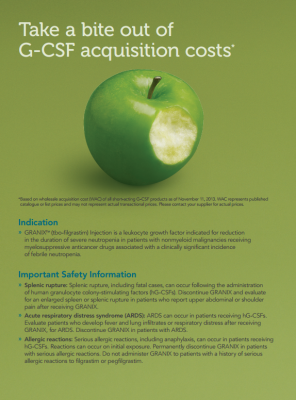Novartis still has to win a patent-infringement lawsuit before it can sell Zarxio, the first biosimilar to receive FDA approval, but experts and advocates indicate the potential rollout of the drug is less important than the fact that the approval has smoothed the way for the four biosimilar applications in front of the FDA.
It also shows drugmakers that the look-alikes in their pipelines have a real chance at capitalizing on the patent lapses of blockbusters like AbbVie’s Humira, which loses exclusivity in 2016.
But an FDA approval can only take a drug so far, and experts noted that a cheaper price may not be enough to guarantee look-alike medications will take hold for one key reason: Patients and physicians are not yet ready to trust that biosimilars offer the same impact and safety that branded biologics offer.
Biologics are never pure copies of one another, and biosimilars mirror but are not duplicates of the branded biologic, which is also known as the reference product. In their simplest form, biologics are like subtle differences in color: an orange hue may have a slightly different mix of red and yellow, from paint can to paint can, but still look orange. A biosimilar will look like the same orange, but its red-yellow composition may differ slightly from the original.
This natural variation is what has made the approval process so slow, and experts indicated that while safety and efficacy are generally important issues, the testing to ensure safety and efficacy in biosimilars had an even greater emphasis because of the nature of the products and the unavoidable variations.
The similar-but-different element has patient-advocacy groups like the Global Healthy Living Foundation (GHLF) excited but cautious. The group focuses on chronic conditions, such as rheumatoid arthritis, which is treated with biologics like AbbVie’s Humira.
Biosimilars have the potential to increase the number of alternative treatments if patients stop responding to a medication, Stephen Marmaras, who heads up the nonprofit’s advocacy arm, told MM&M, but he said a few things need to be ironed out before patients and doctors embrace them. He said the first thing to consider is that the drugs are not the same, and his concern is about interchangeability status, which the FDA has not granted Zarxio, but which serves as a touchpoint in terms of the rules GHLF wants in place for when interchangeable biologics roll out.
Marmaras and his group want states to require pharmacists to let their doctors and their patients know if and when a biosimilar is being recommended as a replacement for a branded biologic.
“I believe that patients and physicians will be much more comfortable adopting biosimilars . . . if we’re transparent in the way that we substitute them,” Marmaras said. He added that it would also be a way to be on the lookout for a different reaction—good or bad—if a biosimilar replaced a branded biologic.
This has been a running theme for biosimilar spectators—worry that an almost-alternative may not be as safe and effective as a familiar biologic.
This is despite the confidence of individuals like Dr. Reyn Archer, chief medical officer at public relations and communications firm Burson-Marsteller, who told MM&M: “I’ve just been watching [the FDA] with this since 2002 and I have partnered with many of the companies that have helped build the pathway . . . they have really tried to balance the idea of innovation and safety and efficacy and that’s why I think it’s taken them so long to come to this point.”
Marketing may be able to cultivate trust.
Express Scripts spokesperson Jennifer Luddy told MM&M in an email that the pharmacy benefits manager will do what it did when it had to ease doctors and patients into accepting small-molecule generics. It educated them about the “science behind biosimilars, and the efficacy and safety profiles of these medications.”
Jacques Mulder, global advisory industry and market strategy leader for consultancy group EY, told MM&M that branded biologics makers may be able to build trust in biosimilars with patients and physicians if they make the company’s history of quality a selling point, a strategy Amgen alluded to in an October presentation.
He added that this issue of integrity will be of an even greater concern for these new molecules, potentially adding to the perception that traditional pharma manufacturers may be the most qualified to produce for new-age biosimilars. “In the biosimilar space, the reputation quality requirements . . . [become] much more elevated versus [the] small-molecule environment,” he said.
Experts could not agree on what the next big biosimilar milestone will be, but Dr. Gillian Woollett, Avalere Health’s SVP and FDA strategy and policy lead, said she hopes things will now move a bit more quickly.
Woollett, who has been watching this space since 1996, said she hopes Zarxio’s approval means things will speed up. “This is a 24-year-old product,” she said referring to Neupogen. “The 12-year exclusivity . . . is not relevant when you’ve got a 24-year-old product.”








